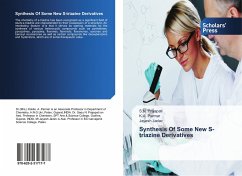![[3,3¿]Bicarbazolyl-, triphenylamine and 1,3,5-triazine based compounds [3,3¿]Bicarbazolyl-, triphenylamine and 1,3,5-triazine based compounds](https://bilder.buecher.de/produkte/30/30850/30850937n.jpg)
[3,3¿]Bicarbazolyl-, triphenylamine and 1,3,5-triazine based compounds
The synthesis and investigation of the properties of glass-forming low-molar-mass compounds and polymers
Versandkostenfrei!
Versandfertig in 6-10 Tagen
32,99 €
inkl. MwSt.

PAYBACK Punkte
16 °P sammeln!
Optoelectronic devices fabricated from organic low-molar-mass and polymeric materials are gaining recognition and attention of the electro-optical industrial community. The most widely used building blocks of hole-transporting polymers and molecular glasses are aromatic amino groups and carbazolyl group in particular. Carbazolyl fragment is interesting as a building block in the design and synthesis of electroactive materials for the following reasons: (1) carbazole is rather cheap starting material; (2) it is a fully aromatic unit providing a good chemical, electrochemical and environmental s...
Optoelectronic devices fabricated from organic low-molar-mass and polymeric materials are gaining recognition and attention of the electro-optical industrial community. The most widely used building blocks of hole-transporting polymers and molecular glasses are aromatic amino groups and carbazolyl group in particular. Carbazolyl fragment is interesting as a building block in the design and synthesis of electroactive materials for the following reasons: (1) carbazole is rather cheap starting material; (2) it is a fully aromatic unit providing a good chemical, electrochemical and environmental stability; (3) it can be easily substituted with a wide variety of functional groups to help the solubility and to tune the optical and electrical properties. [3,3 ]Bicarbazolyl unit is much less studied and used in the design and synthesis of organic semiconductors and other electroactive materials. New macromolecular and low-molar-mass charge-transporting compounds containing [3,3 ]bicarbazolyl and aromatic amino moieties with different arylamino groups as substituents have been synthesized. The thermal, optical and photoelectrical properties of the obtained materials have been studied.








![Heterocyclic Compounds (Pyrazolo[1,5-a]pyrimidine and 1,2,4-Triazine) Cover Heterocyclic Compounds (Pyrazolo[1,5-a]pyrimidine and 1,2,4-Triazine)](https://bilder.buecher.de/produkte/61/61128/61128302n.jpg)



